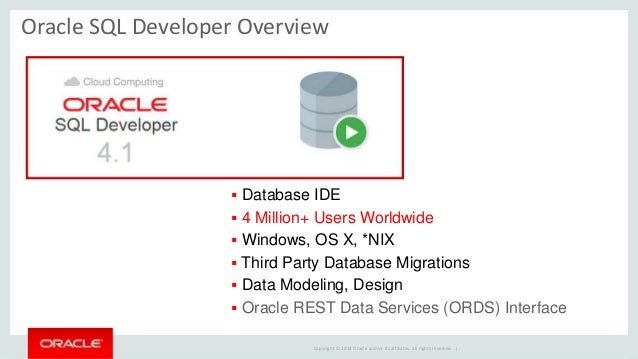
#ORACLE SQL DEVELOPER LOGO MANUAL#
If you get an error during compilation, you may as well see what it is right away instead of having to go through another manual step to type out “show errors” at a prompt.Īfter the procedure, the INSERT statements are of two formats: including specific columns and none at all.
#ORACLE SQL DEVELOPER LOGO CODE#
The line at the end of the procedure code is also frequently used. It also incorporates an exit condition using NOTFOUND. The procedure illustrates the (good) use of OPEN-FETCH-CLOSE when working with cursors in this manner. Of course, you could also select distinct titles and not worry about the comparisons.

You could then compare titles to determine if you had a new title or not. What’s another way the matching titles could have been collected? One way would have been to use a BULK COLLECT where the matching titles are bulk collected, and then each one could be referenced by position (what if the schema setup had allowed multiple copies of a title?). Is VARCHAR2(50) large enough to hold all book titles? Without knowing what the BOOKS table used, we could be at risk here for not having made the variable “big enough” to hold all titles in the table.Ī code improvement here would be to use an anchored declaration such as “matching_title BOOKS.TITLE%TYPE.” No guesswork involved now as the anchored declaration takes care of not only the datatype, but the length as well.Ĭonsidering the cursor, what structure in other programming languages does “FETCH the_cursor INTO matching_title” represent? That structure would be an array, and the loop is essentially the same as looping through an array (or collection in Oracle-speak). The variable named matching_title is declared as a VARCHAR2 datatype with a maximum length of 50 characters. The procedure list_a_rating takes an IN parameter to demonstrate the use of those. The procedure is where the first significant amount of PL/SQL is used. Without a lot of complexity in the schema, it’s hard to have a “real” trigger (or multiple triggers). The trigger is statement level (as opposed to what other level?) based and uses a “NEW” reference. The table of contents omits mentioning of a trigger used in the schema. Further, use of “NATURAL JOIN” would have been another added/useful syntax example. Another enhancement would be the inclusion of a column alias instead of the column for column mapping between the base tables and the view. A minor modification for the view’s DDL statement would be to have used “CREATE OR REPLACE” instead of “CREATE” by itself. The create view statement also includes an implementation of a key versus non-key preserved view (what does key preservation do for you?). The view appears to be simple (in the context of simple versus difficult), but is, in fact, complex. I would have made the transactions_seq sequence simpler via “create sequence transactions_seq.” As many other defaults were left out in the example, why not go all the way and omit the starting and increment by values? The sequences are pretty basic, but also illustrate variations in the starting number. The DDL statements also show examples of inline and out-of-line constraint creation. The three tables include all major constraints (primary key, foreign key, check, not null and unique and the frequency of DBA candidates who cannot rattle these off in an interview is amazing).
Otherwise, the associations can be made via Tools>Preferences>File Types one file type at a time.Īs mentioned, the schema is rich with objects and structure. Upon first use of SQL Developer, the window below appears, and it is a convenient time to make the associations for these very common Oracle files. The first (relatively) minor item is configuring Oracle-related file type associations. Installation of SQL Developer is straightforward, but there are a few steps, which may cause some problems for a beginner and those unfamiliar with what was once known as Project Raptor. I use the term reference structure because the code can be used as a reference for syntax and it illustrates a basic schema or structure complete with referential integrity. Obviously, a quick tutorial is not to make anyone an overnight expert, but as far as expanding upon the Scott schema or the newer sample schemas (HR, OE, SH, etc.) goes, the sample schema in SQL Developer provides a good reference structure or setup. Code within the tutorial shows easy to implement examples of data definition language, data manipulation language, SQL and PL/SQL. Inside of Oracle’s (free) SQL Developer 1.1 product is a tutorial, which includes a little bit about a lot of things in Oracle. GUI interfaces into Oracle are becoming more and more common, and aside from the heavyweight TOAD, other products include SQL Developer, SQL Manager 2007 and SQL Edge.


 0 kommentar(er)
0 kommentar(er)
